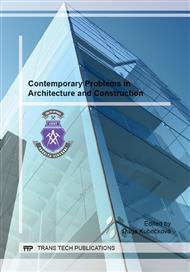p.484
p.491
p.495
p.501
p.507
p.513
p.518
p.524
p.529
The Utilization of Ground Source Heat Pumps (GSHP) for Research Purpose in the Campus of VSB - Technical University of Ostrava
Abstract:
The largest been realized installations of heat pumps in the Czech Republic, where the primary collector of low-potential heat is formed deep wells, is heating complex building of new Auditorium and CIT in campus of VSB Technical University of Ostrava. This building represents two independent functional units (Auditorium with side halls and Information Technology Centre - CIT) with a total floor area of 9234 m2. The original project planned compound heating using district heating as a primary source of heat. Heating the object itself is a combination of floor heating systems and hot-air heaters. During project preparation has changed the project heating and a modern, technically unique and highly cost-effective solution has been designed with heat pump (type rock-water). Currently building heats 10 heat pumps with a total output of 700 kW through 110 wells with a depth of 130 m each. To assess the proportions of individual internal and external sources to the overall heat balance, the verification of systems designed for long-term monitoring of the behaviour of the rock massive around the energy used wells and energy storage options have been proposed and gradually implemented two research measuring polygons. They are located in the area of energy utilized wells. Each of the monitoring wells is instrumented with sensors at a certain depth. This article discusses the implementation of research polygons on experience with the excavation of wells using temperature sensors, a data acquisition system and finally outlines the possibilities of evaluating the measurement data.
Info:
Periodical:
Pages:
507-512
Citation:
Online since:
October 2014
Keywords:
Price:
Сopyright:
© 2014 Trans Tech Publications Ltd. All Rights Reserved
Share:
Citation:


